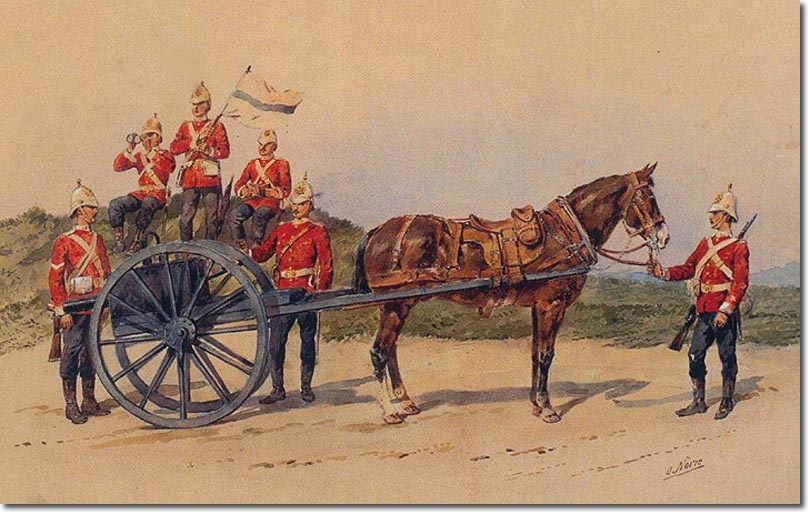|
|

 |
|
The date of this painting by Orlando Norie is given as 1884-1890 but there is no indication as to whether it is the 1st or 2nd Battalion. The white helmet is featured here which was worn on foreign hot climate service. Both battalions would have worn it in the Zulu War of 1879, From there the 1st Battalion returned to the UK while the 2nd went to Gibraltar, then India, Burmah and Aden, returning home in 1893. The background does not fit in with any of the foreign locations so it may be safe to assume that this is the 1st Battalion in the UK where Norie would have had the opportunity to sketch them. The fine detail on the horse harness and uniforms suggests that he drew them from life.
The wearing of the white helmet may be because they had not yet been issued with the home service blue helmets. There may also have been a matter of regimental pride in the white helmet to remind the rest of the army of the regiment's bravery and sacrifice at Isandhlwana and Rorke's Drift. The modern day band and Goat-Major of the Royal Regiment of Wales wear the white helmet for the same reason. But later paintings and photos of the South Wales Borderers circa 1910 show them wearing the blue helmet so the tradition of the white helmet must have been dropped at some point then later revived for the modern day band. There is an officer standing between the horse and the gun, with a scarlet serge undress tunic and a slim brown leather strap either for a water-bottle or binoculars. His tunic has six buttons as opposed to the five stipulated in the 1891 Dress Regulations. He is armed with a sword, suspended from a white leather waist-belt. His helmet has a spike on top while the other ranks have a ball. This is unusual for infantry but it may be because these men are responsible for a horse-drawn vehicle like the artillery. The spike would be dangerous for the horse whilst the men are bending down to fix the harness. The men's undress tunic has a white collar, round cuffs and shoulder-straps, the latter having SWB embroidered on them in red. The white facings were adopted in 1881 but were changed back to green in 1905. The man holding the horse's bridle has a badge on his sleeve which looks like a gunner's badge. The signallers on the embankment have crossed flag badges on their left sleeve. |
Armed Forces | Art and Culture | Articles | Biographies | Colonies | Discussion | Glossary | Home | Library | Links | Map Room | Sources and Media | Science and Technology | Search | Student Zone | Timelines | TV & Film | Wargames